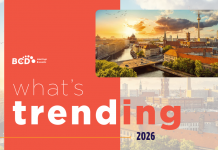In-person events have begun to revive. With 2.5 trillion global events market eager to meet again. The future of events appears to be lot more lucrative, hopeful, tech-savvy, and green.
The events industry’s future will be defined by the year 2022. New research papers, sentiment surveys, exhibition calendars, market trends and growth forecasts show renewed interest in the M!CE sector, which has reinvented and shown exceptional resilience in 2020 and 2021. The impact of business events on the global economy is estimated at US $2.5 trillion, generating over 26 million jobs, and its impact can be tracked in over 180 countries worldwide. Meeting planners strive for responsible recovery, adhering to safety and sanitation protocols, social distancing, and capacity control in accordance with local, regional, and country level regulations. Regardless of the current easing of these measures in many markets around the world, this is an important topic because, as per a survey of event organisers, 65 per cent have explicit policies on safety and security norms for their events.
The ratio between in-person events, hybrids, and online formats should see further changes this year. While 2020 and 2021 have seen the pivot to virtual events and the rise of hybrid events, respectively, 2022 preliminary data indicates the return of in-person components to the events market. While online formats can be used strategically to increase key-message reach, in-person events are a sensory, live, real-world experience that can craft meaningful and long-lasting connections. According to recent data, over 80 per cent of meetings and events should have an in-person component. Furthermore, technological advancements–online event platforms, event apps, and metaverse events–are driving a convergence to multiple event formats being used in different stages of the event – pre-event, during, and post-event–to maximise the user experience in a new omni-event format that is data and on-demand content rich, pushing interaction beyond the single format to expand the single event lifecycle, build an online engaged event community, and generate a revenue stream.
Incentives are designed to reward teams for achieving key performance targets–increases in revenue, company objectives, and project savings–and in particular for showing resilience over recent years. A recent study has shown that 81 per cent of surveyed companies consider incentives very or extremely important for their overall event strategy in 2022. Out of the four traditional event types, incentives have the key strategy importance of boosting the return of long-haul international business events and travel.
Business events, in fact, have always contributed to the promotion of new services and innovative products. A well-executed and promoted product launch has the potential to redefine an industry, influence markets and set trends for decades to come. The original and iconic iPhone launch back in 2007 is still one of the most viewed and utilised success cases to frame the potential these event types can have on an industry. Trade events and exhibitions can have a similar impact on SMEs, adding a valuable sales and marketing channel to bring these services and goods to the competitive marketplace. Business events are strategic macro-economic instruments to attract local and foreign direct investment, having a long-lasting impact on destinations, cities, and countries with a legacy that surpasses the event itself, from infrastructure development, increasing productivity, developing new markets, and boosting tourism. As travel restrictions are being relaxed, a rising number of destinations are pursuing and promoting the unique selling points of their cities with the aim of attracting large M!CE opportunities as a vector of economic growth and recovery. Destination stakeholders that are able to develop, market, and deliver a clear message will be able to attract more business as business travel resumes.
Another important factor is the growing trend toward sustainable practices. Green initiatives are being implemented as part of corporate environmental, social, and governance (ESG) strategies. The events industry must be ready to attend to this increasing demand from an environmentally-aware corporate client audience and include carbon neutrality, offset or reduction of emissions in its overall event strategy. At the last climate conference, COP-26, an initiative called Net Zero Carbon Events was presented to lead the industry towards net zero carbon event emissions by 2050, with 83 per cent of survey respondents indicating sustainability is a factor when sourcing partners for their events. This commitment to reduce carbon emissions impacts all event stakeholders. From organisers to partners, suppliers, clients, associations, and companies may consider carbon neutrality and carbon credit certificates as well as the conscious use of utilities and renewable energy to decrease event impacts in the destinations they choose for their events.
While the positive factors can drive the future of events, there are important barriers that may hinder this acceleration such as staff shortages and rising production costs. Due to redundancies and layoffs in the last two years, there has been a shortage of events professional labour in several markets, as the experienced workforce has migrated to new industries, which are offering higher remuneration. Since this affects the overall event quality and execution as seasoned professionals are no longer available and the current ones need to adapt and learn how to execute multiple types of event formats without proper training for the new technologies available. There are already indicators that the new entrants to the event labour market have less than 12 months of experience and are just starting their careers. As this has a dramatic impact on the event supply chain, the questions being asked in the industry are about the retention and attraction strategies to overcome this staff depletion scenario. In addition to this barrier, the rising cost of energy and food inflation also impact the total cost of executing events while budgets have not yet reached pre-pandemic levels. When factoring that F&B costs are rising, in some cases, events with F&B requirements are charging higher prices now than in 2019.
In order to foster this initiative, carbon calculators and neutral carbon event guides have been developed to support the event industry. The steps that are necessary to plan for neutrality are: event carbon neutrality planning, carbon emission calculation, carbon emission offsetting actions, event carbon neutrality awareness and promotion, and result analysis and future event evaluation.
In conclusion, with the forecasts, trends, research, and survey results, the future of events is starting to become clearer. The sector will still live with safety protocols, learn to maximise the opportunities and incremental revenue of multiple omni-event formats (online, hybrid, in-person, and metaverse), promote the inherent value of business events, face the current challenges, and show how sustainability can be a key driver. With the return of in-person events, a solid roadmap for the industry is starting to be designed. With a 2.5 trillion global events market eager to meet again, the future of events seems to be a lot more prosperous, optimistic, tech-savvy, and green than two years ago.
Thadeu Araujo is a specialist in sales, hospitality, and events-M!CE and has organised over 3,500 events in several countries.














